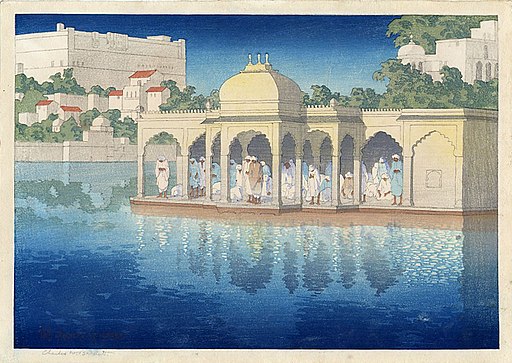
“Prayers at Sunset, Udaipur, India” by Charles W. Bartlett depicts the Maghrib prayer in Udaipur in India. The Maghrib prayer or the ‘”West [sun] prayer” is prayed just after sunset and is the fourth of five formal daily prayers performed by practicing Muslims. This scene beautifully portrays Udaipur, which is also known as the “City of Lakes” or the “Venice of the East.” It is a major city of the Udaipur district in the Indian state of Rajasthan.
This woodblock print was published in Japan by Watanabe Shōzaburō in 1919. Bartlett was one of the very first Western artists to have his work publish in the Japanese woodblock print form, which led to the rejuvenation of this genre and the Shin-Hanga movement in western art circles.
Charles W. Bartlett
Charles William Bartlett was an English painter and printmaker who had studied in London and Paris and worked and exhibited across several European countries. In his 50’s he traveled to India, Ceylon, Indonesia, China, and Japan. He arrived in Japan in 1915, where he met woodblock print publisher Watanabe Shōzaburō who was a dominant force in early 20th-century Japanese art called shin-hanga. Watanabe published 21 woodblocks from Bartlett’s designs, including six prints of Japanese landscapes. In 1917, Bartlett and his wife left Japan and settled in Hawaii. He revisited Japan in 1919, where he created sixteen shin-hanga prints for Watanabe.
Shin-Hanga
Shin-Hanga, which in Japanese means “new woodcut (block) prints”) was an art movement in early 20th-century Japan, that revitalized traditional genre of Japanese art rooted in the Edo and Meiji periods (17th–19th century). It maintained the traditional collaborative system where the artist, carver, printer, and publisher engaged in the division of labor. The alternative was the movement of the creative print, which advocated the principles of “self-drawn,” “self-carved,” and “self-printed,” according to which the artist, with the desire of self-expression, was the sole creator of art.
The Shin-Hanga movement flourished from around 1915 to 1942 and resumed briefly from 1946 through the 1950s. Inspired by European Impressionism, the artists incorporated Western elements such as the effects of light and an expressive style but focused on strictly traditional themes of landscapes, famous places, beautiful women, kabuki actors, and birds-and-flowers.
Shōzaburō Watanabe
Shōzaburō Watanabe (1885 – 1962) was a Japanese print publisher and the driving force behind the Japanese printmaking movement known as shin-hanga. Watanabe employed highly skilled carvers and printers and commissioned artists to design prints that combined traditional Japanese techniques with elements of contemporary Western painting, such as perspective and shadows. Watanabe coined the term shin-hanga in 1915 to describe such prints. Charles W. Bartlett and Hashiguchi Goyō, are among the artists whose works he published.
Much of his company’s stockpile of both prints and their original printing-blocks was destroyed in the Great Kantō earthquake of 1923. In the following years, new versions of many of these prints were created using re-carved blocks; typically, the re-issued “post-quake” prints included changes and revisions in the designs. Watanabe exported most of his shin-hanga prints to the United States and Europe due to a lack of Japanese interest. After the close of World War II, his heirs continued the business, which still operates.
Reflections
- Why did not more Western artists explored the Japanese style of woodblock printing?
- Why did the Japanese woodblock printing influence so many of the early Impressionist Arts?
- How many cultural influences in this work of art?
Prayers at Sunset, Udaipur, India
- Title: Prayers at Sunset, Udaipur, India
- Artist: Charles W. Bartlett
- Year: 1919
- Medium: Woodblock print
- Museum: Honolulu Museum of Art
Charles W. Bartlett
- Name: Charles W. Bartlett
- Born: 1860 – Bridport, Dorset, England
- Died: 1940 (aged 79) – Hawaii
- Nationality: English
- Notable works:
- Prayers at Sunset, Udaipur, India
- Miono-Matsubara
A Tour of the Honolulu Museum of Art
- Prayers at Sunset, Udaipur, India by Charles W. Bartlett
- “Miono-Matsubara” by Charles W Bartlett
- “Female Figure” from the Cyclades: Greek Island Group in the Aegean Sea
- Sarcophagus Relief Depicting Labors of Hercules
- Male Torso of the Hermes Richelieu Type
- “The Bath: Woman Sponging Her Back” by Edgar Degas
- “Water Lilies” by Claude Monet
- “Seated Nude” by Amedeo Modigliani
~~~
“Dare to dance, leave shame at home.”
– Hawaiian Proverb
~~~
Photo Credit: Charles W. Bartlett [Public domain or Public domain], via Wikimedia Commons
Popular this Week








 Sponsor your Favorite Page
Sponsor your Favorite Page SEARCH Search for: Search Follow UsJoin – The JOM Membership Program
Sponsor a Masterpiece with YOUR NAME CHOICE for $5
Share this:
- Tweet
